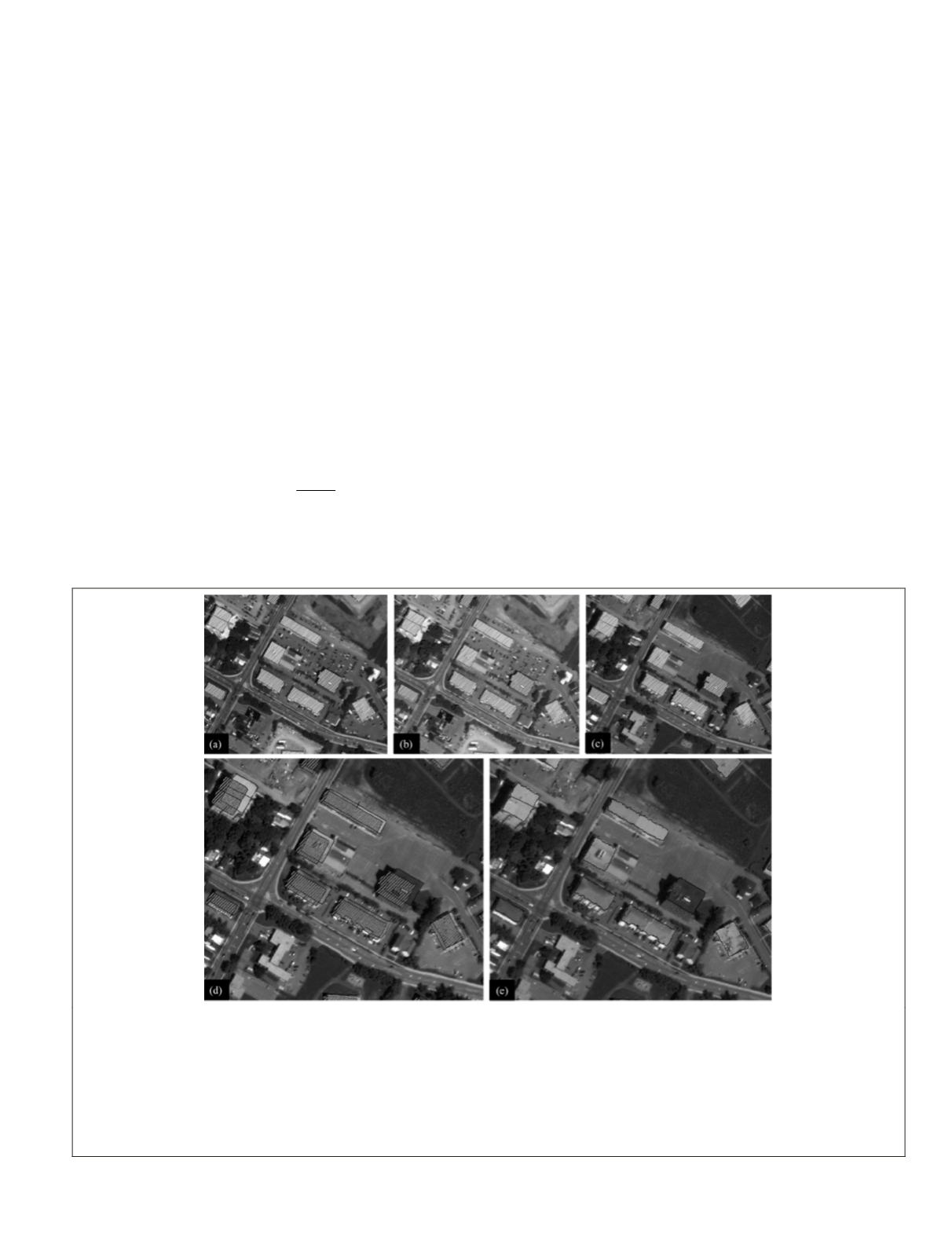
DT3) is registered to the base one using first, second, and third
order polynomials, respectively, in such a way that the coreg-
istration RMSE is less than one pixel. Then, the segmentation
result of the base
image is used as a thematic layer for segmen-
tation of the coregistered target
image. As can be seen in Plate
2, even with high order polynomials, segments do not fit the
actual building borders properly.
In order to quantify the performance of the
PWCR
method
for image coregistration, it must be proved that the segments
generated in the target
image are consistent with the actual
borders of the objects present. Thus, for the purpose of accura-
cy assessment, in each dataset, a group of test patches is con-
sidered among unchanged objects, generally from the build-
ing class (building roofs) since they have distinct borders.
The borders of the test objects are manually generated in the
target
images (building roof polygons). Later on, the overlap of
patches generated in the target
images using the
PWCR
method
are checked against the actual border of the objects generated
manually, as polygons, in the target image. If they are consis-
tent, a high overlap is expected. Therefore, the intersection
of the polygons gives a proper criterion to test the accuracy.
However, in order to check the shifts between the objects, the
union of the objects also matters. Here, an Area Ratio given in
Equation 8 is suggested to be an accuracy criterion:
AreaRatio
A B
A B
=
∩
∪
(8)
where
∪
represents the union of two polygons, and
∩
rep-
resents the intersection of two polygons. If the polygons are
identical (which is the ideal case) the Area Ratio is one. The
closer the ratio to one, the better the accuracy of the coregistra-
tion.
Here, we compare the Area Ratio generated using the
PWCR
method with the Area Ratio generated using a conventional
coregistration method. In the tested conventional method, first
the base image and the target image are converted to orthophotos.
Then, the target orthophoto is coregistered to the base orthophoto
using a second degree polynomial with an RMSE of less than one
pixel. After that, the manual test object borders are generated in
the base orthophoto and the resulting polygon layer is used as a
thematic layer to segment the target orthophoto. Finally, the Area
Ratio for the thematic segments and the actual building borders
in the target image are calculated. Figure 8 depicts examples of
the reference segments generated for this comparison.
Figure 9 shows a larger scale sample building image for
comparison of the results generated by the conventional
method and the
PWCR
method. As can be seen, the borders
generated by the
PWCR
(Figure 9b) properly fit the actual
borders, while the borders in the conventional coregistration
method do not fit the actual building borders (Figure 9a).
Figure 10 presents the comparison of the Area Ratios gen-
erated using the
PWCR
method and the conventional method
for over 25 different test objects (mainly buildings with simi-
lar areas) in each dataset. For each specific test object, two
Area Ratio numbers are presented by a black bullet for the
PWCR
result and a white bullet for the conventional method
result. As can be seen,
PWCR
has higher Area Ratios compared
to the conventional method which means
PWCR
generates
more accurate object borders.
Figure 8. Accuracy comparison between the coregistration results from the PWCR method and the conventional method (using ortho-
rectified images and polynomial coregistration): (a) Building roofs manually delineated in an ortho-rectified base image, (b) Building roofs
manually generated in an original base image (without ortho-rectification), (c) Building roofs manually generated in an original target im-
age, (d) Overlay of building roof generated using the conventional method (extracted from the ortho-rectified base image and transferred
to ortho-rectified target image that is co-registered using polynomial co-registration) (shaded polygons) on actual building borders in the
polynomial co-registered ortho-rectified target image generated manually (hollow polygons). The overlay of the two border layers is used
to calculate the Area Ratio for the conventional coregistration method: (e) borders of building roofs extracted from the original base im-
age (b) and transferred to the original target image using PWCR method. The overlay of (e) and (c) is used to calculate the Area Ratio for
the PWCR method. Since the overlap of the two layers (c and e) was high, they are shown in separate images.
PHOTOGRAMMETRIC ENGINEERING & REMOTE SENSING
July 2016
529


